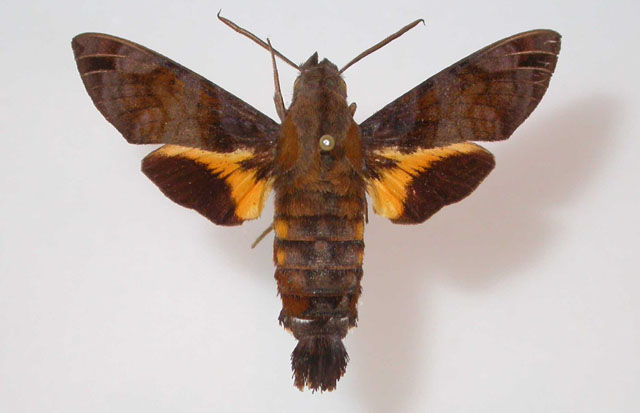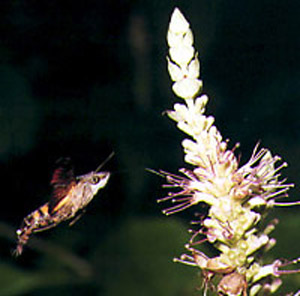Macroglossum pyrrhosticta
|
|
Created as per Hawkmoths of the World, Kitching and Cadiou, 2000; April 2009
Updated as per personal communication with Eric Hossler; December 2011
|
Macroglossum pyrrhosticta
Butler, 1875

Macroglossum pyrrhostictum courtesy of
Jean Haxaire
This site has been created by
Bill Oehlke at oehlkew@islandtelecom.com
Comments, suggestions and/or additional information are welcomed by Bill.
TAXONOMY:
Family: Sphingidae, Latreille, 1802
Subfamily: Sphinginae, Latreille, [1802]
Tribe: Sphingini, Latreille, 1802
Genus: Macroglossum Scopoli, 1777 ...........
Species: pyrrhosticta Butler, 1875
|
MIDI MUSIC
.....It's a Wonderful World.....
copyright C. Odenkirk
ON.OFF
<bgsound src="world.mid" LOOP=FOREVER>
|
DISTRIBUTION:
The Hummingbird Hawk Moth,
Macroglossum pyrrhosticta,
flies in Hawaii, and has an extended range across the Pacific Ocean
to the Philippines and into Asia, including China, Korea and Japan.
FLIGHT TIMES:
Macroglossum pyrrhosticta adults
fly from April through August to October (EH).
Eric Hossler sends the following sighting:
Macroglossum pyrrhosticta - adults feeding at flowers in Pahoa, Big Island, October 2010, at dusk. Many adults also at light in Pahoa town
(at a restaurant - easily a dozen found at one address). I did not see any adults at flowers during the day but I didn't spend a lot of time looking.
ECLOSION:
Pupae probably wiggle to surface from
subterranean chambers just prior to eclosion.
SCENTING AND MATING:Females call in
the males with a pheromone released from a gland at the tip of the
abdomen. Adults take nectar from flowers.
I believe this species is a day flier, but females probably nectar at
flowers at night during ovipositing flights. |
 |
EGGS, LARVAE, PUPAE:
Larvae are referred to as maile
pilau hornworms.
Sphingidae of Hawaii
Return to U. S. A. Table
Return to Sphingidae Index
Return to Macroglossini Tribe
Enjoy some of nature's wonderments, giant silk moth cocoons.
These cocoons are for sale winter and fall. Beautiful Saturniidae moths will emerge the following spring and summer.
Read Actias luna rearing article. Additional online help available.
Use your browser "Back" button to return to the previous page.
This page is brought to you by
Bill Oehlke and the
WLSS. Pages are on space rented from Bizland. If you would like
to become a "Patron of the Sphingidae Site", contact Bill.
Please send sightings/images to Bill. I will do my best to respond to
requests for identification help.
 | 
Show appreciation for this site by clicking on flashing butterfly to the left.
The link will take you to a page with links to many insect sites. |



